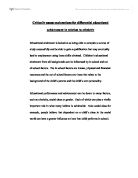“On the whole girls continue to
outperform boys at all levels of
education in the UK from Key Stage 1
to higher education.”
Ethnicity:
‘The overwhelming evidence is that the British education system, like that of many other countries, favours those who are already privileged, and puts further obstacles in the path of those who are disadvantaged.’
Chris Livesey:
I think that when revising this statement it shows that students that
come from a poorer social class and when English is not their first
language, it makes it difficult for them to show that they have an
understanding in the class environment, leading to a lack of
communication with teachers. Therefore creating a barrier for teachers
to help the disadvantaged.
This table shows the statistics of students from different ethnic
backgrounds gaining 5 GCSE’s, between 1996 and 2000.
- Innate intelligence – Outline and analyse the arguments for ‘natural intelligence’ and discuss how and why the tests were used to select pupils on this basis.
Middle class students are seen as “Naturally” more intelligent compared to working class students.
Most exams are aimed at middle class students, as exams are mainly to do with memorisation and as most middle class students have tutors and different daily routines compared to working class students, it is definitely easier for them to study and memorise work in order for them to pass in their exams.
“When it comes to social class, the differences are even more striking. In 1998 only a fifth of those whose parents were in unskilled manual jobs achieved five GCSE passes at grades A to C. In contrast, more than two-thirds of children of the professional and managerial classes got five GCSEs at this standard.”
‘If intelligence was something innate and equally present, on average, in all races, then the tests could not be measuring it – they must, that is, be invalid, unfair, and biased when used with blacks, Hispanics, and so forth.’
Litigating intelligence: IQ tests, special education, and social science in the Courtroom by Rogers Elliot
- Testing intelligence – discuss the issues around how intelligence may be measured. Is it possible to measure intelligence?
IQ tests for testing intelligence in order to place children in which category of education they should be in, was first established in 1944. The Educational system thought that they could measure intelligence through a student’s IQ scores. The question is: what is intelligence?
‘The problem with the term intelligence has never been defined adequately and therefore nobody knows what an IQ test is’
IQ testing and exams are mainly based on academic knowledge and memory, in order to help the majority of students in middle class to pass so that they could carry on their education in university, this relates back to education and social class.
- Inheritance or environment? – discuss the evidence that ‘genetic inheritance’ does not account for differences in educational achievement.
Intelligence is accountable based on the way a person thinks, and their style of learning, that’s where the genetics intervenes with a person’s level of “intelligence’’. Genetics doesn’t help a person gain knowledge, but helps them learn in a certain way that helps them intake and maintain that knowledge.
“Give me a dozen healthy infants, well formed, and my own specified world to bring them up in and I’ll guarantee to take any one at random and train him to become any type of specialist I might select – doctor, lawyer, artist, merchant, chief, and yes, even beggar man and thief, regardless of his talents, penchants, tendencies, abilities, vocations and race of his ancestors. There is no such thing as an inheritance of capacity, talent, temperament, mental constitution, and behavioural characteristics.”
‘Watson, 1925 p.82’
Given this evidence, ‘genetic inheritance’ does not account for differences in educational achievement.







